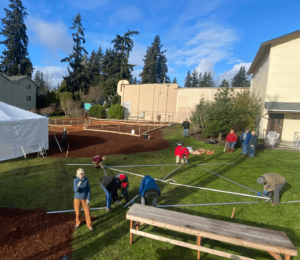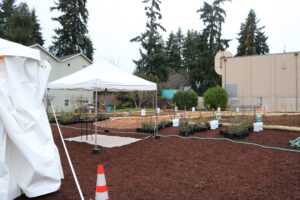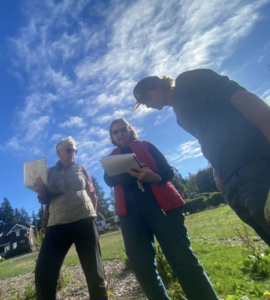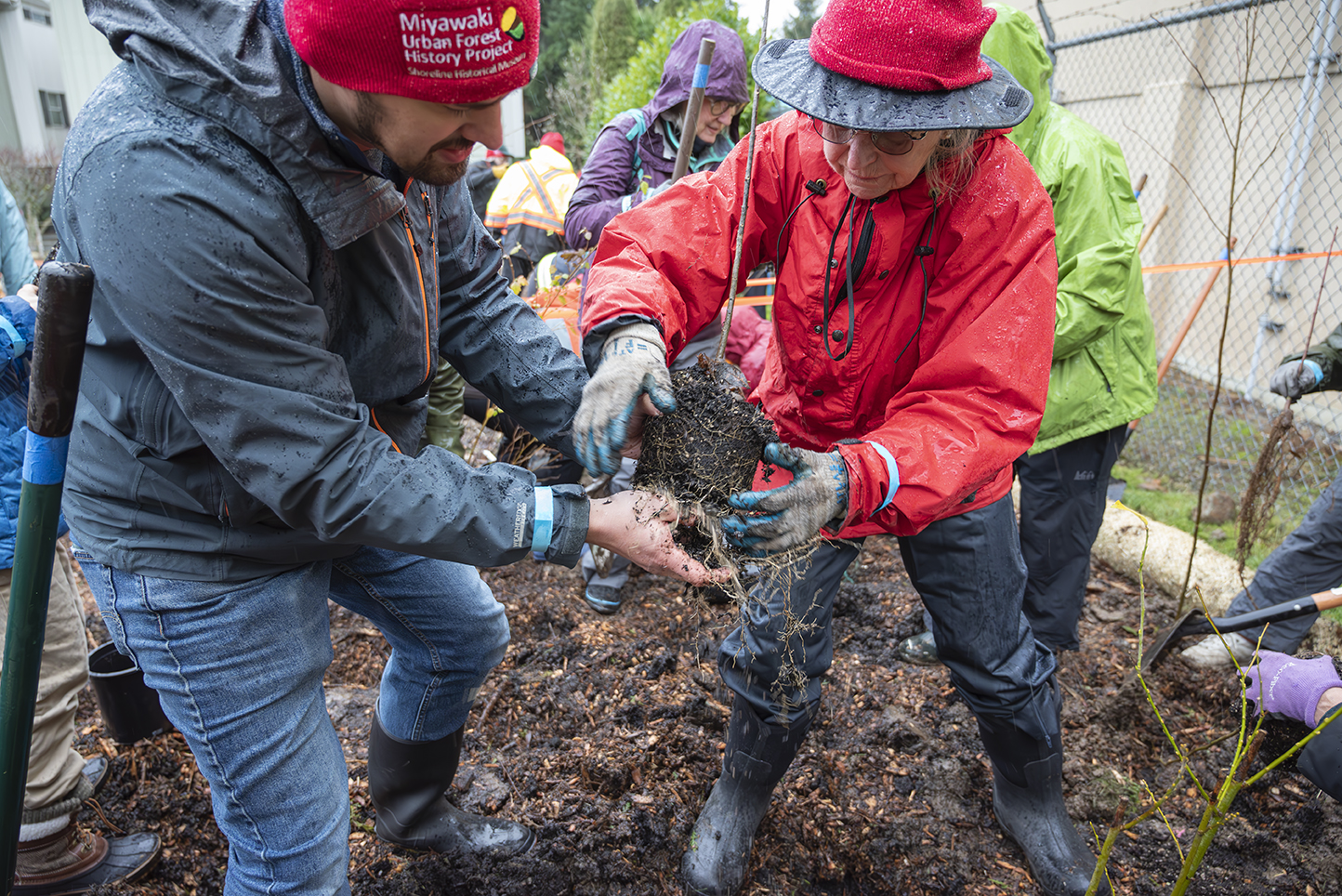By Catherine Endicott, Judy Maccully, and Sarah Philips,
Environmental Rotary Club of the Puget Sound, Washington State, USA
Have you ever seen the stars align for a service project? Imagine 100 no-shows and then 100 people showing up unexpectedly, transforming the entire event into a success! This was the situation when members of the Environmental Rotary Club of the Puget Sound, Shoreline Rotary, the Rotary Club of Lake Forest Park, and 300 other community volunteers planted over 1,200 trees and shrubs in one day to create a Miyawaki Urban Forest at Shoreline Historical Museum in early December 2023. Shoreline is between Puget Sound and Lake Washington, a few miles north of the City of Seattle in King County, Washington, USA.

Community volunteers planted over 1,200 trees and shrubs to create a Miyawaki Urban Forest.
The Miyawaki Urban Forest History Project aims to create a beautiful and sustainable urban forest that celebrates the history of the area and promotes environmental awareness.
“We are excited to be a part of this community-driven idea which was developed by a group of people invested in preserving the natural world and highlighting Indigenous relationships to our landscapes,” says Environmental Rotary Club president Kimberly Peterson.
The idea for the project took root about a year ago, when Environmental Rotary Club member Sarah Philips and a small group of concerned citizens petitioned the Shoreline Historical Museum Board to create an urban forest on a vacant field adjacent to the museum. The concept included three interrelated elements:
- a green space of native plants
- a community gathering spot, and
- an outdoor museum and exhibit space.
Community organizer Sally Yamasaki served as project lead, working with Environmental Rotary Club members Sarah Philips, Judy Maccully, and a core group of committed volunteers under the guidance of Shoreline Historical Museum Director Kenneth Doutt. Together, we succeeded in planting the 3,000 square foot forest in one day and a year ahead of schedule!
How it happened:
The Shoreline Historical Museum Board loved the urban forest idea, but was not sure how to get started with landscape plans, not to mention raising thousands of dollars to fund it. The idea of a Miyawaki Forest began to emerge.

Trees and shrubs lined up to be planted in the urban forest.
A Miyawaki urban forest is a small forest that can be planted in urban spaces. It can be as small as two parking spots. The strategy was created by Japanese botanist Akira Miyawaki. Unlike traditional urban forests, which are often composed of one or two species of trees, Miyawaki Urban Forests have a diverse mix of native trees and shrubs planted closely together in a small area. This high-density planting method allows the forest to grow 10 times faster and 30 times denser than a traditional planted forest. The planting method makes pesticides unnecessary. In three years the forest will be self-sustaining, not needing watering or weeding.
These unique forests are not only beautiful, but they also provide a host of benefits to the environment and to the people who live in urban areas. One of the key benefits of Miyawaki Urban Forests is their remarkable ability to sequester carbon dioxide from the atmosphere. The high-density planting method allows these forests to store up to 40 times more carbon than traditional urban forests. Additionally, these forests also provide many other benefits, including the reduction of urban heat island effects, reduced air and noise pollution, and improved biodiversity. Overall, Miyawaki Urban Forests are an innovative and effective way to improve urban environments while also mitigating the effects of climate change.
Our small group of dedicated volunteers reached out to the Sugi Project, which promotes urban biodiversity, and met associated urban forester Ethan Bryson of Natural Urban Forests. Ethan became our lead conduit in helping this project take shape. After 15 months of meeting, the Miyawaki Forest Friends, working in collaboration with the Shoreline Historical Museum, developed a draft project design and budget. The Environmental Rotary Club became one of the early sponsors with a grant of $500. This initial seed money inspired contributions of over $14,000 from other local Rotary Clubs and a Rotary District Grant.

Judy Maccully, Environmental Rotary Club member; Sarah Philips, Environmental Rotary Club member; and Ethan Bryson, Natural Urban Forests urban forester.
Then an anonymous donor provided funds for the landscape final design, the soil prep, and the 1,200 native plants of 42 species. The Rotary funding was designated for the forest entryway and artwork, which will reflect the rich history of the community. In addition to creating a welcoming entrance for visitors, this area will serve as a community gathering place and host educational programs. The final funding piece was a King County Conservation District grant to provide a cistern, hardscaping, programming and signage. Thus, Rotarians’ $14,500 leveraged almost $78,000 in additional funding!
Not only will the environment be cleaner thanks to the plantings, but the forest visitors will become aware of the role trees and plants play in improving our air, ground, and overall well-being. The walking paths and signage are intentional educational opportunities. There will be benches providing visitors an opportunity to sit within the quiet forest in the middle of a very busy urban landscape.
The Environmental Rotary Club is particularly proud of the pollinator garden which the Club funded adjacent to the tiny forest. Sponsoring the pollinator garden in conjunction with the Miyawaki Forest Planting Day provided an opportunity for the community to help spread the carefully-chosen native seeds on “pollinator hill,” while learning more about the importance of bees, butterflies, and other pollinators to the health of our local environment, and to discover Rotary’s commitment to Operation Pollination.
Reflecting on the overwhelming success of this project, we Rotarians credit it to the involvement of many different organizations and local citizens who know how to organize a multitude of groups with a variety of motivations. Trying to make the environment a healthier place can seem insurmountable for the most stalwart person or group. Having a project with a sense of urgency, the fact that volunteers could succeed with little or no training, a short time commitment, and visible results within hours seemed to be the right recipe for success.
Additionally, we believe Rotarians can make the most of our networks by being a facilitator and collaborator, and not always needing to lead the charge. There are many organizations doing great work. These organizations have “subject matter expertise.” Rotarians can work with leaders of different groups like these and make a big impact.
Now the Miyawaki Forest Friends are planning the next stage of financial and volunteer support. There is an exciting story to tell around the region about reforesting in urban areas. If your Rotary Club is interested in hearing more about the Miyawaki Urban Forest History Project or if you want to create your own Miyawaki Urban Forest, please contact us at [email protected]. Project members from the Environmental Rotary Club would be glad to tell your Club about this project as a virtual guest speaker at one of your future meetings.
Photos by Sally Yamasaki, Dan Benson, Jeff Jensen, and Gary Hawkey

